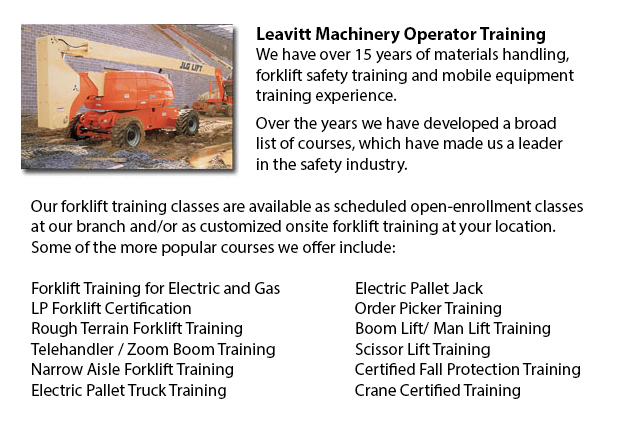
Markham Manlift Training - Different manlift training programs include the review and content of manlift devices. An important part of the program is the practicum where students demonstrate their practical ability and knowledge to safely operate a manlift. A prerequisite to Manlift training is the fall protection training, which may be incorporated in the training based on the particular needs of the customer.
Course Content
The program content includes: the impact of performing unsafe acts or operating unsafe machinery, pre-shift equipment check and work area survey requirements, Lifting device equipment definitions, Review of load capabilities, the specific equipment requirements and safety decals, Review of related sections of the OSHA Standards as well as the CSA Standards and Review site specific Hazards, together with controls for safe use of a lifting device.
Demonstration and Evaluation Content
The evaluation and demonstration part of the course includes: Using a spotter or a signaler when needed; Proper personal protective equipment or P.P.E. as required; using a lift only on solid and level ground; Using a correct fitting harness or fall arrest device; Using the lift with all other workers clear of the job place; Aware of load limitations etc. and other specs as set out by the manufacturer; Having all associated machinery safely stored on the lift platform; Pre-shift work area survey and machine inspection; Ensuring a smooth and safe operating speed for different plant conditions and isolating off the work area when major work projects are to be completed.
Each of the trainees will undergo testing to make sure that they can safely operate their machine.
Manlift Safety
As the manlift is capable of lifting materials and personnel more than 20 feet in the air, these machinery pose a particular amount of danger and can be dangerous machines if not used correctly. As the danger is so apparent, lift owners and operators are careful to properly maintain their machines and follow right safety precautions and operating procedures. The ratio of accidents involving this specific machine is rather low.
The safe utilization of the manlift, boom lift and scissor lift is up to the operator of that equipment. They need to understand all of the responsibilities that go with operating the machinery and how to utilize the lift vehicle safely. The most basic safety features on the machine are safety decals and the operating manual. These show vital information about the maintenance, operating procedures and safety machines.
Newer lift models will come along with guidebooks and decals in place. Technically, the operating manual must be stored on the lift itself. If you are purchasing a second-hand lift, it is important to ensure that the guidebook is included and that important decals haven't been painted over. The restraints which prevent operators from falling and the guardrails are other vital safety features. These are standard and mandatory on all kinds of lifts.
-
Markham Forklift Certification Schools
Markham Forklift Certification Schools - Forklift Certification is mandatory in North America. Hence, forklift training programs are essential both for businesses and for people seeking jobs in industries as forklift operators. Forklift training focu... More -
Telehandler Training in Markham
Telescopic handlers normally called telehandlers for short, are a very popular piece of heavy construction equipment. They are commonly utilized in the construction and agricultural trades. These machines have maximum reaching capability and can get... More -
Markham Zoom Boom Training
Markham Zoom Boom Training - Zoom Boom Training is designed to train operators on variable reach forklifts. The objectives of the training are to impart an understanding of the physics of the machinery, and to outline the operator's tasks. This progr... More -
Markham Heavy Equipment Ticket
Markham Heavy Equipment Ticket - A heavy equipment operator will utilize different construction machinery, depending upon the nature of the task at hand. The large equipment are constructed to carry out specific tasks in the most efficient method for... More -
Markham Scissor Lift Training
Markham Scissor Lift Training - When operating a scissor lift, they must be utilized competently so as to protect the safety of the other employees inside the workplace and to protect the safety of the machine. Competent operators are trained to driv... More -
Markham Manlift Operator Training
Markham Manlift Operator Training - The aerial lift or manlift is a specialized kind of hydraulic platform which is designed to raise a person vertically giving it an alternate name of a vertical personnel lift. These machines are widely used for a m... More -
Markham Heavy Equipment Training
Markham Heavy Equipment Training - The two most common kinds of heavy equipment training are classed into the categories of machinery; equipment that is fashioned with tracks and those with rubber tires. The tracked vehicle are heavy duty equipment s... More -
Markham Forklift Safety Training
Markham Forklift Safety Training - Those wanting work in industries that utilize forklifts should undergo a forklift safety training course before becoming a certified operator of a forklift. There are various ways to go about getting forklift safety... More

Forklift Certification Markham
TOLL FREE: 1-888-254-6157
Markham, Ontario
forkliftcertificationmarkham.com
Email Us
About Us


